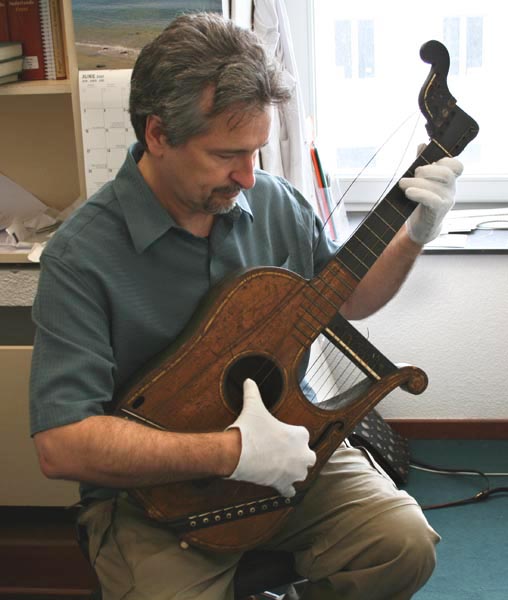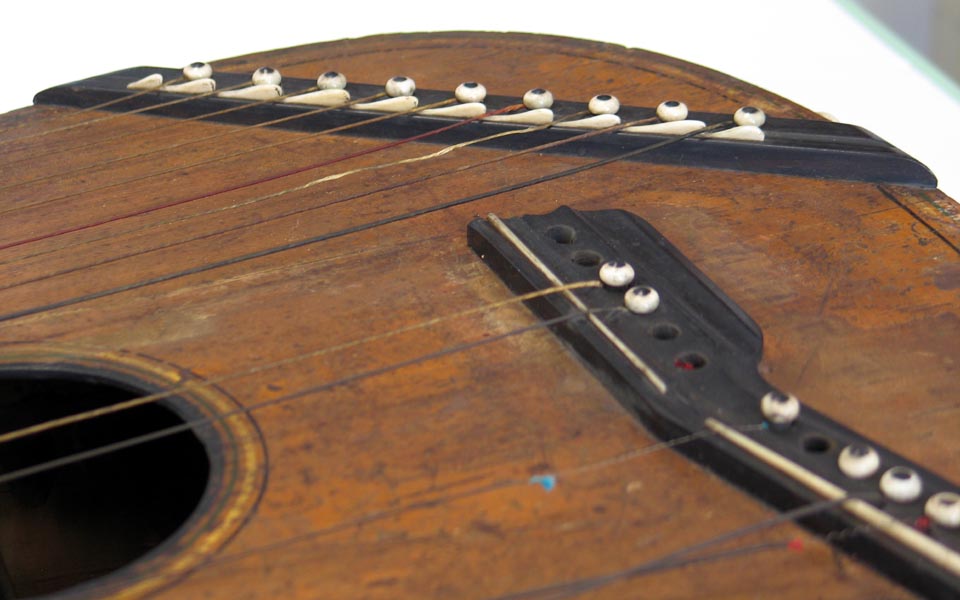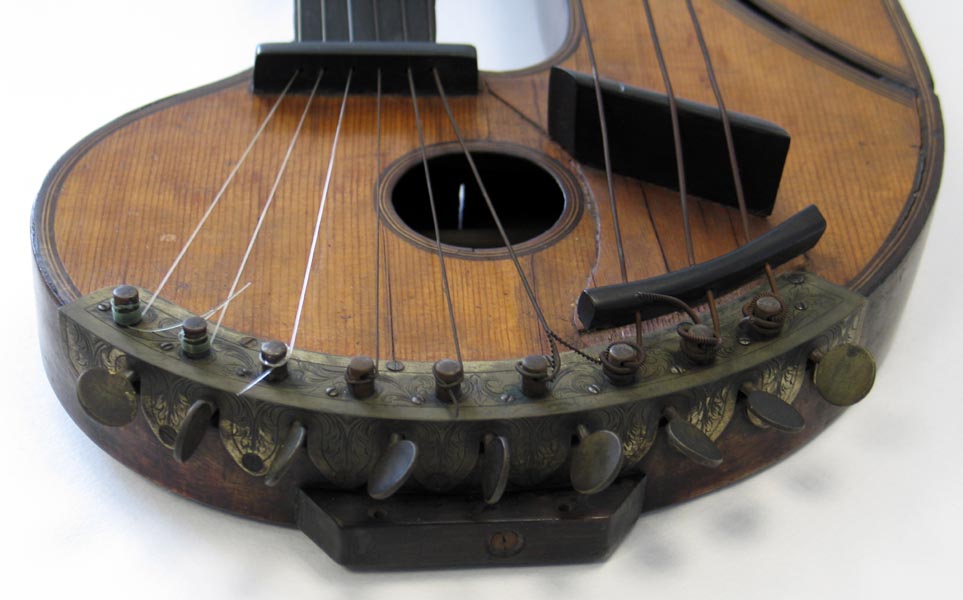Last week I took you behind the scenes at the Brussels Musical Instrument Museum as Benoit Meulle-Stef (Ben) and I got up close and personal with their amazing “harpe-gitarre” in 2007.
There were two other fascinating off-exhibit harp guitars that I was keen on inspecting and the staff obliged us with those as well.

Like last week’s #1550, Brussels MIM catalog #2490 is thought to be an English instrument from the first quarter of the 1800s. Ben and I agree as it has the general quality and vibe of the Edward Light harp-lute family of instruments, though much simpler in its decoration and aesthetics.
However, most curiously, its inventory page now includes the notation “Munchs et Charpentier 1832” – I assume some mark or label was located inside. The date makes sense, but the distinctly English style and crude construction (from a guitar standpoint) seem strange for French guitar builder Charpentier. This provenance obviously now needs further investigation.

There is one other very similar instrument, possibly by the same maker, also unlabeled.
So this seems to be more than an arbitrary “one-off” (being so far a “two-of”)!

This one was fairly petite, and whether you think the design lovely or odd (I’d say a bit of both), it was definitely a step in the right direction. It was, in essence, a gut-strung version of the now-common and popular Sullivan-Elliott 20-string harp guitar configuration – a genuine musical predecessor, but a good century and a half earlier!

Above, you can see I am “strumming” or “plucking” the neck strings while having full access to the nine “super-trebles.”

I also noted that it would be much easier to play trebles and six basses simultaneously on this layout than the Sullivan-Elliott hollow arm.
As no literature has ever been found describing these instruments, we don’t know the intended tuning or imagined playing techniques, let alone the maker or the instrument’s original name. Standing on its four button feet, it must have been a charming parlor instrument – at least as musical, if not as attractive – as the harp-lute family instruments in their c.1800-1830 heyday.



All 21 tuners are simple pins – again, it makes me think that the maker came from the harp-lute side of things rather than any kind of actual guitar background.


I like how the trebles get their own private f-hole…

…but the subs’ single little “nostril-hole” is not nearly as attractive!

 This was our third “destination instrument” – an incredible Friedrich Schenk bogengitarre! I’m still mystified by his incredibly long, thin curvilinear soundhole.
This was our third “destination instrument” – an incredible Friedrich Schenk bogengitarre! I’m still mystified by his incredibly long, thin curvilinear soundhole.

Unlike the later Mozzani chitarra lyras and other knockoffs, Schenk’s featured a hollow sound chamber in place of its headstock.


Believe it or not, it was Benoit himself who finally pointed out this instrument’s century-old identification error to the museum – along with its unique custom bridge installed by the famous virtuoso Napolian Coste. I won’t go into all that again here, as I presented these details (and much more) on my Lacote page some time ago (another ever-expanding article that has become a “must-read” for anyone looking into Decacordes, Heptacordes, Carulli or Coste “customization”).

As Ben recalls, the string holes from Schenk’s original bridge can be seen underneath the soundboard – yet no marks from the original wide bridge can be seen on the top. Perhaps Coste sanded and refinished the top.
There were a couple of other harp guitars and numerous other off-exhibit holdings that I would have loved to have seen, but Ben and I didn’t want to push our luck. Most (all?) are now online, including many of those floating strings relatives, the arch-citterns (of all periods and types):
Above: Renault, 1804. The well-known image of Coste with his instruments includes one of these distinctive instruments (with his modified bridge, of course!).
Below: A Deleplanque klaviercister – how incredibly rare!

I also took a peek at a rare book in the office with other examples of citterns with theorbo extensions:

The rest of our time at the museum was spent browsing the galleries. I already added to the site their Decacorde and this beautiful 1807 harp guitar by Lamblin of Ghent, Belgium.

I have a particular fascination with the double-neck instrument in the middle of this case of arch-citterns (1783, anonymous).
Curiously, Brussels has theirs classified as a “cittern” whereas all others have considered it some sort of guitar. As have I all these years – you’ll see one in the Harp Guitar Composite Forms Gallery (clues: 5 and occasionally 6 single strings on the neck, gut strings tied to the bridge and typically gut frets).
There seems to be zero literature on these – no advertisements, notices, music, nor nary a name of any kind – yet they were prolific for a time and built by the finest guitar builders (circa 1785). A research project indeed for some brave individual!
Next time: The rest of our wonderful 2007 Belgium adventure!







I’m a fan now. Beatifull art. Thinking of wood DNA would link some items to an area or craftsman. Carbon dating migh be more accurate these days. All it takes is money.
The Schenk bogenguitarre’s headstock is very similar to Wishnevsky’s first harp guitar design, which I believe he dubbed “the Fathead.” I doubt that he was aware of this instrument at the time, though….. https://www.facebook.com/photo.php?fbid=10153914162507080&set=pb.644452079.-2207520000.1463404014.&type=3&theater